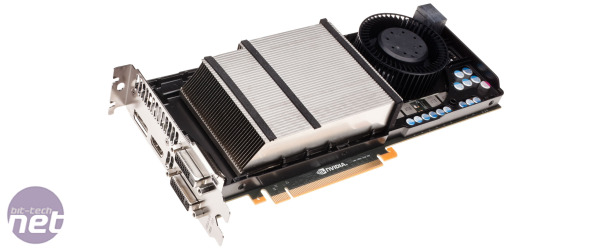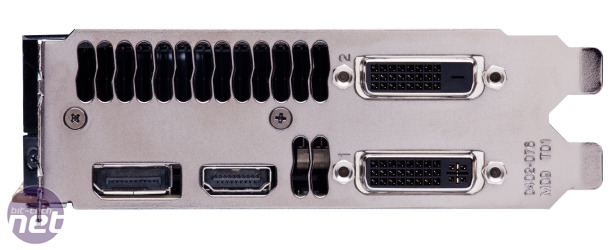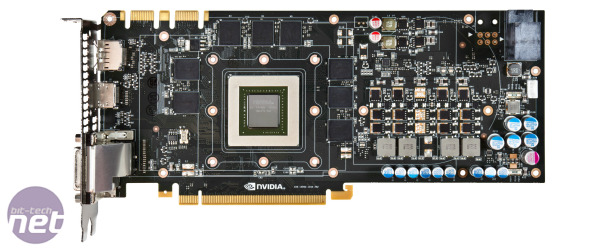
The Card – All this and only 195W
Finished in glossy black plastic and Nvidia green trim, the GTX 680 2GB is a little more restrained aesthetically than the HD 7970 3GB’s black and red shroud. At launch, every partner card should be using the same stock Nvidia reference board and cooler, but partners will be bringing custom cooled, and even watercooled versions to the market soon.While it’s no surprise to see the reference GTX 680 2GB fitted with a dual-slot cooler, what will come as a shock is that the card’s TDP is just 195W; 49W less than the GTX 580 1.5GB it replaces in Nvidia’s product stack, and 35W less than AMD’s competing HD 7970 3GB. This is despite the increased core clock speeds, and huge increase in stream processors. Thanks 28nm!
This GTX 680 2GB’s surprisingly low TDP means that the card requires only a pair of 6-pin PCI-E power connectors, top mounted in an odd staggered array where both connectors face each other. This array of connectors is mounted into a solid plastic housing that physically attached to the PCB. This means that, even if you were to strip the stock cooler off and fit a water-block, the stock GTX 680 2GB will still require two expansion slots. Interestingly, there’s also room on the PCB for a third 6-pin PCI-E power connector. Could Nvidia have further plans for this GPU yet?
Measuring in at just 257mm, the PCB is also surprisingly short for a range-topping graphics card. The GTX 580 1.5GB measures in at 267mm, while the HD 7970 3GB measures in at 275mm. We wouldn’t go so far as to claim the GTX 680 2GB is Mini-ITX friendly, though.
To the rear IO, Nvidia has fitted four outputs, all of which can be used simultaneously thanks to the GTX 680 2GB’s improved Nvidia Surround support. A pair of DVI ports, one dual-link and one standard, HDMI and a full-size DisplayPort should make hooking up that wall of monitors easy. Venting is in place on both levels of the rear IO, and there’s also a small vented area along the top the card next to the pair of SLI connectors.
Cooling is handled via an 80mm radial fan fitted to the rear of the card, which blows air through a large central fin stack. Rather than a vapour chamber, the GTX 680 2GB uses three embedded copper heatpipes fitted beneath the aluminium cooling fan stack, with all three converging over the GPU’s heatspreader.
The card’s power circuitry is located beneath the radial fan, so while the card’s eight 512MB GDDR5 chips are actively cooled by the heatsink, the power circuitry isn’t. There are four power phases dedicated to the GPU, with a further pair of power phases to the top of the card powering the 6GHz GDDR5, for a total of 6+1 power phases. Interestingly, a power phase has been deliberately left off the reference design (in the middle of the four GPU phases), further highlighting that either there’s more to come from this PCB, or that it may been reduced during its development cycle.
Rounding off the card is PCI-E 3.0, (although due to Ivybridge’s delay, we’re still waiting on a PCI-E 3.0 compatible CPU) and support for the DirectX 11.1 feature set, although again, DX11.1 and its Windows 8 launch vehicle are still months away from release.
Right, technology explained, PCB examined, and tech specs specified. Bring on the benchmarks!

MSI MPG Velox 100R Chassis Review
October 14 2021 | 15:04












Want to comment? Please log in.